By Saul Roth
The American Psychological Association and the Association for the Chiefs of Police both have their own police psychological sections. The average police officer in his career will see 14 decaying bodies, 10 sexually assaulted children, and co-workers injured a couple of times accidently or intentionally. The officer himself will likely be shot at once and injured more than one time. With statistics like this, PTSD will be a problem for many police officers. For male soldiers in country for the Vietnam War, 15 percent had PTSD. Civilians exposed to violence have a 9 percent rate of PTSD. Police officers involved in traumatic events have similar percentages as civilians suffering PTSD (Liberman, Metzler, & Fagan, 2002).
Liberman et al. (2002) studied officers from New York City, San Francisco, and San Jose. Twelve hundred officers of all three departments were sent surveys, of which 733 were returned. Fifty percent of the officers were white, 22 percent were black, and 28 percent were of Hispanic/Latino origin. Of those surveys, 79 percent were male and 21 percent were female. Administrative stress was separated from critical stress. The assignments that were handled less frequently were the hardest to manage psychologically. Findings indicated that officers who experienced more administrative stress handled the critical stress more poorly than other officers. The women in this study experienced a similar amount of stress as their male counterparts. The female officers did report more discrimination, though. The women also reported more frequent arrest of violent persons. This might be because a person might be more prone to become violent with a female police officer because she is viewed as more physically vulnerable. Police officers of large urban departments are going to deal with more problems with bureaucracy than officers of smaller departments. This coupled with more possibilities of being involved in a critical violent situations makes police work in large urban cities very stressful (Liberman et al., 2002)
One of the unspoken stressors is the possibility of being killed in the line of duty. It does not happen often, but the threat is always there. The U.S. keeps statistics of fallen officers on Internet sites such as the Officer Down Memorial Page and officially by the Federal Bureau of Investigation in its Uniform Crime Report. France just started its first website in memory of fallen officers. There, 79 police and 74 gendarmes were killed in the line of duty between 2000 and 2012 (Valeria, 2013). PTSD usually follows a very traumatic incident. Traumatic events often result in behavioral changes. Typical responses include fear, disbelief, numbness, lack of orientation, and denial. While some people will be fine after this event, others will have psychological difficulties (“Post-Traumatic Stress Disorder,” 2001).
PTSD changes the body’s reaction to stress. Hormone levels are increased and this alters the nervous system (“Post-Traumatic Stress Disorder,” 2001). People experiencing PTSD will usually keep experiencing the causal event in different ways, such as nightmares, recurring images, and negative reactions to anything that reminds him/her of the incident. PTSD is an anxiety disorder. It can cause the suffering person to experience rapid heartbeat and breathing, headaches, and stomachaches. Moreover, the effects of PTSD are not always immediate. It can happen weeks or even years after the causal incident, though symptoms usually do appear within three months of the underlying incident. The medical cause of PTSD is unknown, though research has found that previous traumatic events can make the PTSD worse (“Post-Traumatic Stress Disorder,” 2001).
Typical symptoms of PTSD include nightmares, problems falling asleep, loss of appetite, fear, depression, memory loss, difficulty making decisions, social withdrawal, crying, avoidance of anything that reminds the person of the incident, and fear for persons close to the affected person (“Post-Traumatic Stress Disorder,” 2001).
Cortisol levels can determine the amount of stress a person is under. It can determine if a person is suffering from PTSD. Cortisol can be measured from blood, urine, and saliva. Violanti (2007) completed a study of 92 police officers in the Buffalo Police Department in which he measured cortisol levels were monitored using saliva. The officers that reported having moderate or high symptoms of PTSD had more adverse effects with their cortisol levels than those who did not. Cortisol levels rose faster in these individuals and also receded more slowly. These levels demonstrate how officers will likely respond to acute and chronic stress negatively in the future. It also demonstrates that some officers with PTSD are not “shutting down.” This is shown in their over-reactivity, exaggerated startle response, sleep disruption, and nightmares (Violanti, 2007).


Recent Comments